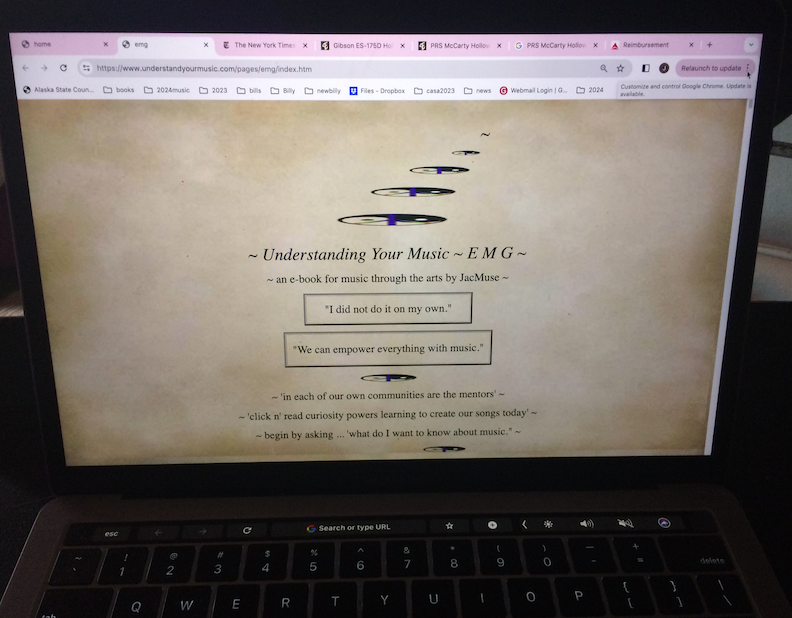 |
The origins of an e-book ... :) With a quote from professor Dr. Joyce Honeychurch, of the University of Alaska, Anchorage faculty, at dawn of a new era of creating computer e-curriculum circa 1987 ...
While we've come a long way since '87, during my formal collegiate public school teacher training here in Anchorage, Alaska, in 1984, professor Dr. Honeychurch encouraged us to think beyond a teacher centered classroom to continually develop new curriculums; whereby any learner's existing knowledge is the first key for entry, the starting point then developed within a curriculum of proven academic standards and measures. |
About this e-book. This is my opus in taking up that challenge; that by powering up a laptop and opening this musical arts e-book, the magics of many learning styles; to play with and sift ideas to imagine new combinations, work through rote styled learning challenges to success, print and complete written measures of vocabulary and concepts, spark curiosity and pursue 'what if' questions, and to learn about music and its most complex theories by ear, these all become possible in an e-book web page format, energized by the curiosity a learner brings, with their existing knowledge sparking off a lifetime of discovery learning in the musical arts. Spanning the basics; from first spelling out pitches of scales, triads and chord progressions of J.S. Bach, on through to the complexities of Americana improvisation through J. Coltrane's post bop symmetry and phrasing into the future through the principles of forward motion moving through musical time. Mentor ~ student dialogue. Yet written always with the learner in mind, a dialogue between mentor and student, with one's own self expression of art through composition and collaboration. All of these discussions are organically hyperlinked, woven together by their various commonalities. There's 28,000 and counting ... internal links in this fully formed, stand alone e-book. That an e-book can also be on the 'global' www platform, which this e-book is, exponentially expands our classroom learning dimensions of discovery, the fellow learners and new friends who share our own interests in art and music, and that learners will become the teachers to new learners as the successive generations pass. Thus, an "E-book on pad / laptop", individualized mentor guided learning with potential global resource additions. |
 |
What a story. Understand Your Music joins the first seven (7) letters of the alphabet and the numbers one (1) through fifteen (15). Empowered by written notes audio assisted, we begin with the ancient notes 'A through G' and quickly move on through to the organizational math of the Mediterranean Greeks roughly 3000 years ago. Then after a brief Euro stop in 1725, our story moves true west to the melting pot Americana shores to discover our own collection of songs and their composers, their theoretical components and evolutions that bring together our many cultural attributes, woven together by the rhythms of Americana life into music. For here in AmerAfroEuroLatin Americana, and from it's origins, the original seven pitches are tuned so to handily include the five notes that we find in between the seven, combining to create the 12 tones of our fully modern Americana palette that we still use everyday. |
One by one. Each of the 12 pitches are examined in many ways; individually one by one, within closed loops and in groups with other pitches, in looping rhythm patterns, in arpeggios and harmony, in phrasing and forms for writing songs, and always with a view of the vast spectrum of style within the Americana songbook; from children's songs and folk and blues, rock and pop, and right on into the complexities of modern jazz, along the way learning to 'jazz up' any song and style we meet along the way. |
The 'general relativity' of music theory. A complete melody comprised of three or four notes is probably a song for kids, a melody of five or six notes brings us clear to the blues, folk and gospel styles, genres and hues. A seven note 'pop' melody also brings the potential of the complete harmonic resource of the combined 12 tones. Melodies with eight unique notes surely lean us to the jazz side of our style spectrum. There's a jazz melody with 9 different notes included in this e-book. There's a jazz song with 23 different chords, imagine that :) All of this 'academia mathematica' underlies the development of music theory topics throughout this work, providing a combined theory / style perspective of our the artistic resources we hold in common, for telling and understanding the theories of our Americana stories from our origins to today. For truth be told, we've all been using the same musical notes all along, with each successive generation jazzing them up in their own 'new' ways along the way, creating the Americana songbook. |
With guided mentorship and the magical hyperlink text, our story takes on a more 'circular' nature, we've now a sphere of the knowledge where we can hyperlink to connect points of one topic to another. Each learner's existing knowledge, strengths and curiosities lights up their pathway as they choose which links to pursue. These thousands (28k+) of hyperlinks within, are most often a vocabulary word, and become a 'mouse click' jump, can take a learner to a next level of challenge, or to explore a related idea, where more links forward await. And through the web browser capabilities that motor this e-book, can click them right back to continue in their mentor guided, measurable curriculum. So when curiosity beckons and their own 'light goes on', these hyperlink 'accelerators' help vault a learner through the educational components within this e-book, which structures a range of ideas and theories commonly found in a BA college level degree which is focused on the AmerAfroEuroLatin musical arts, its performance and how it may help to relate them to a life in showbiz. |
Peter and Mary Craig and all our ancestors.
|
Acknowledgements. Superheart felt thanks to my family and these artists and educators, whom contributed to my musical education over the last 50 years or so. Today enabled by the magical hyperlink of modern text, their collective 'words of wisdom' and the 'theory of whatever' is in their words, and thus can be woven all throughout this musical arts theory e-book. Author's note. Near all of their quotes included are paraphrased, and most cases rewritten after decades of time, so presented here in my own words to best express the artistic idea and principles I learned from their words, here and now passed along through the magics of the now ancient aural tradition. |
|||||||||||||||||||||||||||||||
|
|||||||||||||||||||||||||||||||
To Dr. James B. Miller
|
|||||||||||||||||||||||||||||||
To college professor Dr. Elizabeth Hayden
|
|||||||||||||||||||||||||||||||
To college professor Dr. Yenoin E. Guibbory
|
|||||||||||||||||||||||||||||||
"Get the rhythms solid first, then straighten out the pitches." "There's love and community in big band jazz."
|
|||||||||||||||||||||||||||||||
Jim 'Sticks' Crawford, pictured just left of center.
|
|||||||||||||||||||||||||||||||
wiki ~ Clarke Terry "Learn the bass line story of a song first." "Pair 1/8th notes with vowels 'a e i o u' to swing 1 and 2 and 3 and 4 and ... 1 and ... 'daadle deedle dydle doedle doodle ... 'try that lick fast 50 times ... :)
|
|||||||||||||||||||||||||||||||
wiki ~ Bill Watrous
|
|||||||||||||||||||||||||||||||
"There's always plenty of room at the top."
|
|||||||||||||||||||||||||||||||
|
|||||||||||||||||||||||||||||||
|
|||||||||||||||||||||||||||||||
|
|||||||||||||||||||||||||||||||
"Two good choruses of 12 bar blues ..." "Keep the eyes moving when reading ... regardless of the results."
|
|||||||||||||||||||||||||||||||
|
|||||||||||||||||||||||||||||||
Included here by permission.
|
|||||||||||||||||||||||||||||||
... "In show biz, you must be present to win." ... "There's no money in those frets Joe :)" ... "What this town needs is more band leaders."
|
|||||||||||||||||||||||||||||||
"Learn the song's original recorded version first."
|
|||||||||||||||||||||||||||||||
|
"Gimme' the Muddy walkdown in 'G' please."
|
|||||||||||||||||||||||||||||||
Ken B Burns "Burns' 'Jazz' series documentary is must see t.v."
|
|||||||||||||||||||||||||||||||
John Lennon. As teens growing up in NYC metro, my mates and I skipped once in a while and went into the City for the day. We'd usually end our day trip in Central Park, and up around the East 70's, hoping to bump into The Lennon's, who were known to often go for a family walk in the park across the street. Lennon's song "Give Peace A Chance', is a central pillar of the philosophy that energizes this art music book. A simple song, a few chords and the truth, a 'call and response' energy of a true message to sing together, to create a better world for all. |
|
||||
Used by universe permission from J. Lennon. |
|||||
"You change the world by being yourself." |
 |
"Take the 'e' out of ego and go !" |
Find a mentor / e-book / academia Alaska. Always good to have a mentor when learning about things new to us. And with music and its magics, nice to have a friend or two ask questions and collaborate with. Seek and ye shall find. Local high schools, libraries, friends and family, musicians in your home town ... just ask around, someone will know someone who knows someone about music and can help you with your studies in the musical arts. |
|
Always keep in mind that all along life's journey there will be folks to help us and also folks we can help ... for we are not in this endeavor alone :) The now ancient natural truth is that we each are responsible for our own education. Positive answer this always 'to live by' question; 'who is responsible for your education ... ? |
Intensive tutoring. Luckily for musical artists like us, the learning dip of the 'covid years' can vanish quickly with intensive tutoring. For all disciplines; including all the sciences and the 'hands on' trade schools, that with tutoring, learning blossoms to 'catch us up.' In music ? The 'theory' of making musical art is built with just the 12 unique pitches, so easy to master with mentorship. And in 'practice ?' Luckily old school, the foundation that 'all responsibility for self betterment is ours alone.' Which in music, and same for all the arts, means to do what we really love to do ... to make music :) |
 |
"These books, and your capacity to understand them, are just the same in all places. Always bear in mind that your own resolution to succeed, is more important than any other one thing." |
|
Academia references of Alaska. And when you need university level answers to your questions and musings, and especially if you are considering a career in music and looking to continue your formal studies, begin to e-reach out to the Alaska University Music Campus communities and begin a dialogue with some of Alaska's finest resident maestros ! |
|
~ |